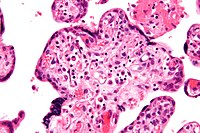
Photo from wikipedia
BACKGROUND Growth retardation during the first year of life is frequently observed in prematurely born infants. Few reports have considered the effects of maternal emotional distress and perceptions of care… Click to show full abstract
BACKGROUND Growth retardation during the first year of life is frequently observed in prematurely born infants. Few reports have considered the effects of maternal emotional distress and perceptions of care burden on the outcomes of these infants. OBJECTIVES This study investigated the physical growth trajectories of prematurely born infants treated in neonatal intensive care unit and determined the effects of perinatal factors, maternal emotional distress and perceptions of care burden on growth retardation at 12 months' corrected age. DESIGN Retrospective chart review and prospective cohort study. SETTING Single neonatal intensive care unit and follow-up outpatient clinics at a maternity and neonatal hospital. PARTICIPANTS 288 mother-infant pairs in the retrospective chart review and 169 dyads in the prospective cohort study. METHODS Medical records of prematurely born infants, perinatal factors and physical growth over a 1-year period were retrospectively reviewed. For the prospective study, mothers completed the Self-Rating Anxiety Scale, Perinatal Post-traumatic Stress Disorder Questionnaire, and Condition Management Effort Scale when infants reached 3 months' corrected age. The generalized linear mixed model was applied to explore effects of maternal emotional disorders and perceptions of care burden on growth retardation at 12 months' corrected age. RESULTS The retrospective data showed 13.9%, 10.1%, and 10.1% retardation for head circumference, length, and weight, respectively. Birth weight was negatively associated with physical growth retardation. Delayed breastfeeding initiation, younger mothers, and lower 5-min Apgar score were associated with head circumference retardation. Male sex, higher gestational age, and delayed breastfeeding initiation were risk factors for length retardation; male sex, higher gestational age, and younger mothers for weight. The prospective study showed that head circumference, length, and weight retardation rates were 18.3%, 10.3%, and 16.3%, respectively. Male sex and birth weight, were still significant, while others were not. Moreover, alternative models based on these included factors revealed that maternal perceptions of a higher care burden was a risk factor for overall growth retardation and maternal post-traumatic stress disorder only for a weight problem. CONCLUSIONS Physical growth remained a significant problem for prematurely born infants during the first year. This study identified perinatal factors, the level of maternal emotional distress, and perceptions of care burden were related to adverse infant's growth outcomes. Multidisciplinary interventions targeting maternal emotional distress and perceptions of care burden should be developed to promote the growth of prematurely born infants within the first 3 months after birth.
Journal Title: International journal of nursing studies
Year Published: 2020
Link to full text (if available)
Share on Social Media: Sign Up to like & get
recommendations!